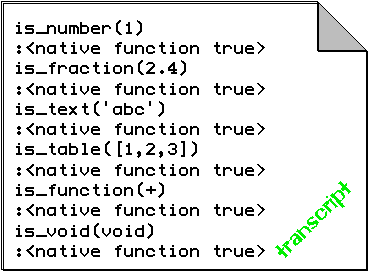By now it is fairly clear that Pico
values are partitioned into a number of distinct groups, called
types. A value belongs to exactly one type and can never
switch from one type to another. On the other hand, simply reading
the text of a program is generally not sufficient to determine the
type of the values that will be bound to the various variables and
parameters used in the program. For instance:
will assign either a number or a text value to the variable x, depending on the value for a retrieved from the current dictionary. As it is, the value of a could have been set using a totally unpredictable function, such as accept. The only way therefore to determine the types of values manipulated by a program consists of evaluating the program.Pico provides a number of native functions to identify the types of values as they are computed in a program:

The functions
is_number,
is_fraction,
is_text,
is_table
and is_function
generate either true
or false
depending on whether the value of their single argument is a number,
a fraction, a text, a table or a function. The function
is_void
is used to determine whether the value of the argument is void; this
value, accessible through the native variable
void,
is the only value of a type distinct from the five others, and is
generally used to indicate the absence of value. Examples will be
given in the next chapter.